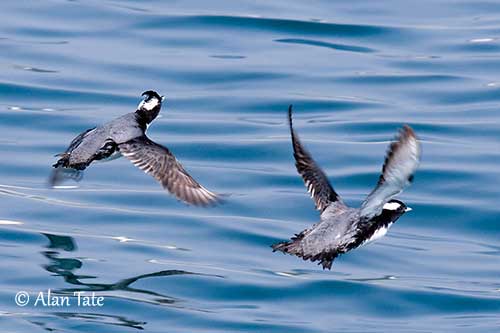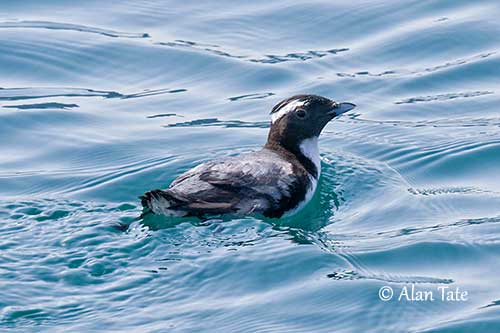
Fr: Guillemot du Japon
Ang: Japanese Murrelet – Crested Murrelet
All: Japanalk
Esp: Mérgulo Japonés
Ita: Urietta del Giappone
Nd: Japanse Alk
Sd: Japansk alka
Photographers:
John Anderson
John Anderson Photo Galleries
Alan & Ann Tate
AA Bird Photography
Text by Nicole Bouglouan
Sources:
HANDBOOK OF THE BIRDS OF THE WORLD Vol 3 by Josep del Hoyo-Andrew Elliott-Jordi Sargatal - Lynx Edicions - ISBN: 8487334202
Wikipedia, the free encyclopaedia
Bird Research News Vol.7 No.9 - Japanese Murrelet by Yutaka YAMAMOTO Wild Bird Society of Japan
JAPANESE MURRELET - Synthliboramphus wumizusume
Postbreeding dispersal and drift-net mortality of endangered Japanese Murrelets
By John F. Piatt and Patrick J. Gould
Japanese Murrelet
Synthliboramphus wumizusume
Charadriiformes Order – Alcidae Family
INTRODUCTION:
The Japanese Murrelet is a small Alcidae found on rocky islets and reefs in Japan, Russia and South Korea warm waters. It is also known as Crested Murrelet.
Like most Alcidae, this species is built for diving and swimming, rather than for flying. Its short wings are more efficient through the water than in the air.
It is threatened by crows and rats that kill adults and chicks and take the eggs. Like numerous seabirds, it suffers from entanglement in fishing nets and disturbance on the breeding grounds. The small population is rapidly decreasing due to these threats.
The Japanese Murrelet was designated a natural treasure in 1975 by the Japanese government, and the species is legally protected in Japan, and occurs in several protected areas.

DESCRIPTION OF THE BIRD:
Biometrics:
Length: 26 cm
Weight: 183 g
The Japanese Murrelet in breeding plumage has blackish and bluish-grey upperparts. The underparts are white, including the throat, whereas flanks are mostly greyish-black. The short, rounded tail is black above and white below, like the wings.
The head is black with black, long, narrow feathers on top of crown, forming a crest. A conspicuous white stripe extends from top of each eye to the nape where both markings meet. Black extends on face and chin, down to the hindneck where some fine white plumes are visible during the breeding season.
The short bill is pale blue-grey with dark culmen. The eyes are blackish-brown. Legs and webbed feet are dull yellowish-grey.
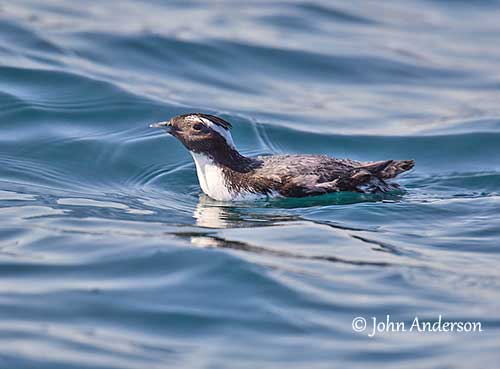
Male and female are similar. The adult in winter lacks crest and white head stripes, and white fine plumes on the hindneck. The crown is black like the eye’s area. Crown sides are often white.
The juvenile resembles adult in winter, but it appears browner above.
RANGE:
The Japanese Murrelet breeds along the seacoasts and on islands off E and S Japan and S Korea, and possibly in Russia, especially Peter the Great Bay.
It usually winters offshore from breeding sites.
HABITAT:
The Japanese Murrelet breeds on rocky islets, headlands and seacoasts. It winters offshore, usually in temperate subtropical waters. It is more pelagic and often far from land.
It forages at sea to the edge of the continental shelf. However, it also feeds inshore when abundant food sources are concentrated near the surface by upwellings or converging currents.
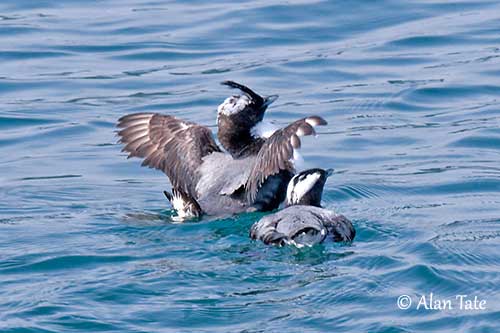
CALLS AND SONGS: SOUNDS BY XENO-CANTO
The Japanese Murrelet gives several types of calls such as “pidju, pidju…” and “chieet”. It utters a “byubyubyubyu” at night at colonies, and an abrupt “chi chi chi chi”.
If parents and young become separated, the chicks give wailing distress cries and adults utter loud calls while searching for their young.
BEHAVIOUR IN THE WILD:
The Japanese Murrelet feeds primarily on planktonic crustaceans of genus Euphausia. Small larval fish is taken all year round. During summer while foraging in Sea of Japan and S Sea of Okhotsk, it feeds on shrimps, crustacean larvae, small shellfish and small fish such as sardines and banded blue sprats.
It often feeds in small groups, diving into the sea or foraging on the surface. It dives during less than 45 seconds at depth of 10-20 metres.
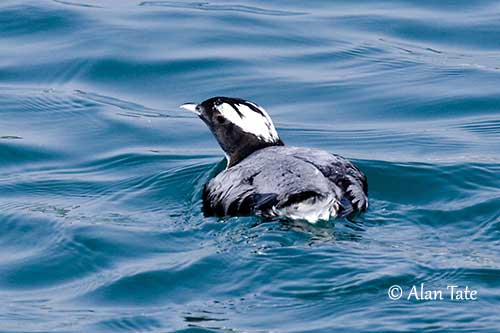
The breeding behaviour of the Japanese Murrelet is poorly known. They are usually monogamous.
From some observations, copulation occurs at nest. The courtship displays are unknown, but we can suggest that the black-and-white head pattern and the crest are enhanced by adapted postures during displays.
The female lays large pyriform or ovoid eggs and the chicks are precocial. Both parents share all the nesting duties.
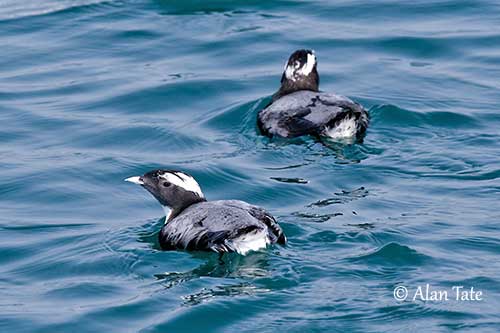
The Japanese Murrelet winters offshore, but close to its breeding sites. The post-breeding dispersal occurs within warm current flowing, and especially at sea SE of Hokkaido, where Oyashio and Kuroshio currents meet.
They return to the colonies between mid and late February. The movements are over short distances and probably related to food availability.
The short wings of the Japanese Murrelet are mostly made for swimming through the water than for flying in the air. However, it flies with rapid wingbeats and over short distances.
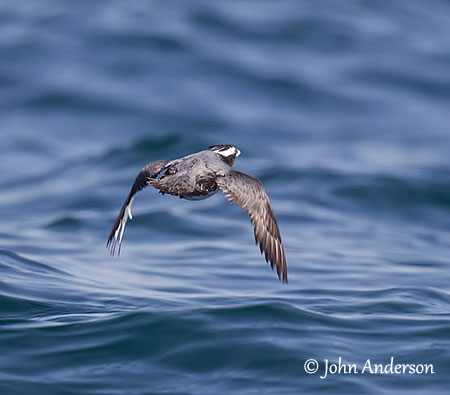
REPRODUCTION OF THIS SPECIES:
The Japanese Murrelet returns to its breeding sites in mid-to-late February, and the laying occurs between mid-March and late June/early July. These monogamous birds show high mate and site fidelity.
This species is colonial nester, but in scattered small groups or single pairs, due to reduced population size. It breeds on reefs and remote islands of Japan and S Korea, and in temperate waters.
It nests on reefs and cliffs, in sedge grasslands, on forest floor, in stone walls, rock crevices and cavities, or in short excavated burrows in soil or under tree roots. It may use an abandoned nest burrow of other species. They have nocturnal habits at colonies.
The female lays 1-2 pyriform or ovoid eggs. The incubation starts when the first egg is laid. Male and female incubate for periods of 24-72 hours during 33-34 days. Both eggs hatch in late April/ early May. The downy chicks are brownish-grey above and white below. The crown is dark whereas cheeks and throat are white.
They are precocial and leave the nest 1-2 days after hatching. They reach the sea during the night by following the calls of their parents. They are fed by both adults until they are fully grown, about one month later. The family swims offshore and travels during several hours.
Eggs and young chicks are usually taken by introduced predators such as rats and other small rodents.
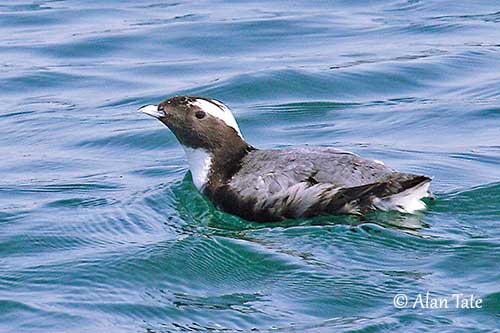
PROTECTION / THREATS / STATUS:
The Japanese Murrelet’s population is declining due to predation of eggs, chicks and adults by crowns, gulls and introduced brown rats, disturbance at breeding sites that may involve desertion of nests by adults, entanglement in fishing nets and oil pollution.
The global population is approximately estimated at 2,500/9,999 mature individuals, equating to 3,500/15,000 individuals. This population is rapidly declining and the Japanese Murrelet is currently listed as Vulnerable. It is legally protected in Japan.
